I had been to Nehru Institute of Mountaineering (NIM), Uttarkashi, one of the best mountaineering institutes in Asia, as a kid – the genesis of my fascination with mountaineering. I longed to join the Institute and learn some mountaineering skills. The opportunity came knocking on my door just after I completed my bachelor’s degree.
Class Profile: NIM course
About 65% of the total strength of the trainees comprised of army jawans. 30% were the locals (the village folk) who teach/organize adventure courses at various places in India. The rest 5% were people like me (most of whom left midway).
On the first day (and this continued for the next 5 days), we were supposed to get up at 5 in the morning and assemble by 6 am. There was no supply of hot water and tap water was too cold to have a bath. Nehru Institute of Mountaineering is situated on a hill top 4 km away from the main market of Uttarkashi. In the morning, we were supposed to run down (intermittently mixed with rigorous exercises) to the market. Once we reached the mountaineering institute, further exercises followed. On the second day, we were tested for our physical fitness, in which we were supposed to do as many push-ups as we could do in a minute – we were made to do this after our daily exercises. My rope mates (read group mates) achieved the following statistics: 49 pushups in 1 min, 47 in 1 min, 48 in 1 min, 38 in 1 min and me: 7 in 1 min. Clearly, I was the most ill-fitted (physically) person for the mountaineering course. The profiles of my 4 roommates:
- Ghatak: Ghataks are the top 8 people in an army regiment who are physically the fittest and daring among the lot.
- Army personnel with Gharwal rifles.
- Former karate champion: aged 35 (at that time), had a black belt in karate and was an avid trekker.
- A local from Uttarkashi and a professional trekker. Organizes trekking tours for people in and around Uttarkashi and also conducts adventure courses for various schools in Delhi.
- Me: Inactive for the past 1 year
The Mountaineering course begins…
Knot tying:
The course at mountaineering institute started with tutorials on how to tie various knots (around 15 knots and 4 hitches), which would be useful for us during the entire mountaineering course. We were given practical lessons on how to pitch a tent, how to pack a rucksack, the various mountaineering equipment in use. Evenings were reserved for films related to mountaineering.
Wall climbing:
On the third day of the mountaineering course, we were taught how to climb an artificial wall. Climbing artificial wall is fun, but requires a lot of arm strength (if one uses the wrong technique). After climbing the two indoor walls, I could not even move my arms. Most of my rope mates did this quite easily.
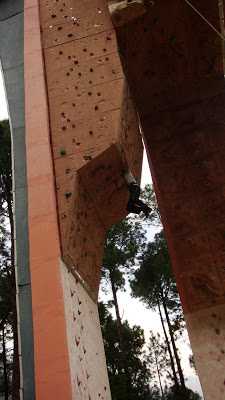
Artificial Wall Climbing
Trek to Tekla:
Day 4 onwards, we used to trek to Tekla (Nehru Institute of Mountaineering‘s rock climbing area, about 9 kms from NIM) every morning carrying a 15-20 kg rucksack on our backs. During this course of 9 km, we used to run for about a km or two. It was an uneven terrain. We were totally exhausted once we reached Tekla. Reaching there, we practiced yoga asanas followed by breathing exercises.
At Tekla, we were taught how to grip the rock, and were lectured on principles of rock climbing. Subsequently, we were taught anchoring and belaying.
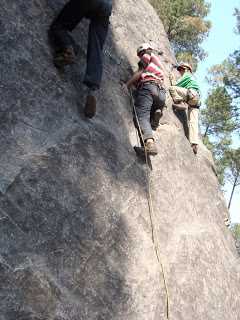
Roped Climbing 1
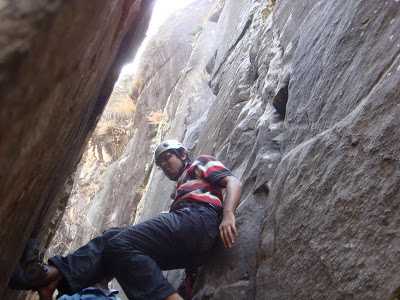
Roped Climbing 2
Rock craft: Rock climbing lessons at NIM
We were taught different types of rappelling techniques, how to belay, climbing up and down a chimney, etc. Rock climbing lessons were a fearful experience for me, more so because I was afraid of heights, but finally I started enjoying rock climbing and rappelling.
After finishing rock craft, we were to develop skills in snow craft. For that we had to trek to a place called “Gujjar Hut”. Gujjar Hut was 24 km from a village called “Bhukki”. We were supposed to complete the entire distance on foot gaining height from 4000 ft to 12,800 ft. Our first stop from Bhukki to Gujjar Hut was Tel (8300 ft). We camped at Tel for the night and then resumed our hike the next day. It was 12 km from Bhukki and really tiring and difficult trail. The enormous weight of the rucksack (25-30 kg) further slowed us. Carrying such a load on this (almost vertical) track was too much for me. I was on the verge of experiencing vertigo. My rope mates sensed this and immediately took control of me. I rested there for a while, eating a packet of biscuit. Then my instructor helped me cross that precarious path.
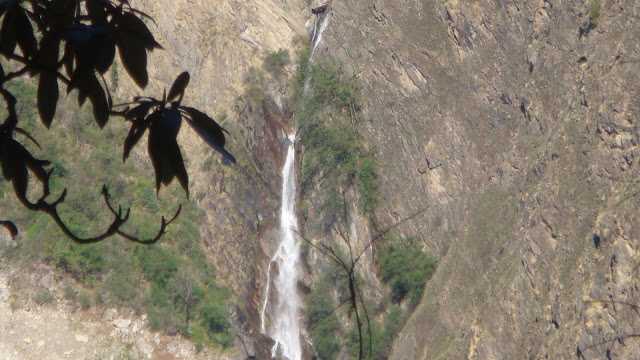
A waterfall en-route to Tel
With my rucksack lightened up (my rope mates helped me with some of my stuff), I moved fairly easy for the rest of the path.
Next day we headed towards Gujjar Hut- gaining height from 8300 ft to 12800 ft. It was a jungle trek and we moved along a river for most of the time. There were times when we had to walk vertically up. It seemed the mountain would never end. The intermittent patched of snow that crossed our paths were really fun to witness and walkthrough. After walking for about 7 hours, we reached Gujjar Hut. We were briefed about the protocols that we were supposed to stick to and were shown our toilet areas (we were supposed to dig up a cavity on the ground and do our stuff and then cover it back again).
Snow Craft:
Physical activity at higher altitudes is extremely difficult. Moreover, any activity was more challenging because we were wearing snow shoes (picture yourself wearing a kilogram heavy shoe). After running for around 25m, I felt a sudden vacuum in my chest and fell down; there were very few trees at this height and it was difficult to breathe. The instructors there were helpful and did not force me to do anything. They asked me to engage myself in breathing exercises and emphasized that I breathe through my nose. After lunch we were given lessons on how to climb a snow covered mountain, how to get down. It seemed fun in the beginning with so much snow and moving up and down. But it was indeed challenging a task as my breathing was troubling me here as well.
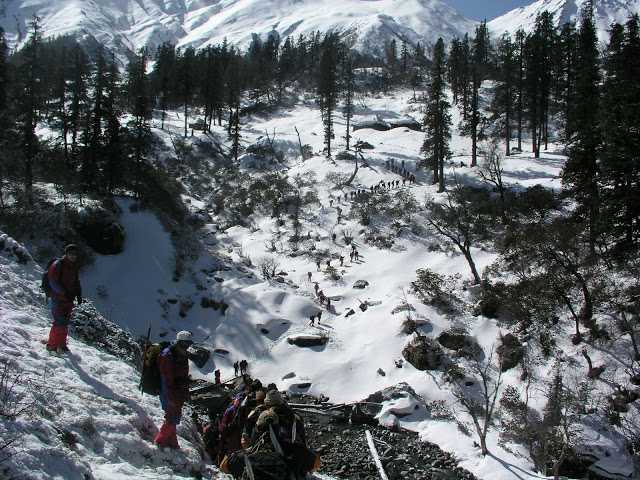
Moving to the practice area
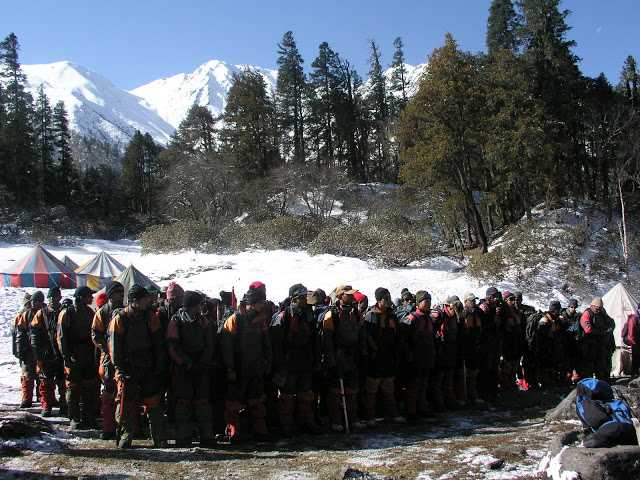
Morning Assembly
In the afternoon we had acclimatization walk to a nearby lake (Khera Tal) – again a scenic beauty. We were given lectures on perils of mountaineering and concerned medical disorders viz. AMS (Acute Mountain Sickness), HAPE (High Altitude Pulmonary Edema), frost bite, metal bite, chill blain, etc – stuff we might face when we go higher up for ice craft.
We were taught about general precautions and survival tactics on high altitude areas. Mornings were particularly difficult in these areas; for most of the time the hands were numb. In the nights, there was no light. We had to carry our torches around and were ordered not to go out after the dinner time. There was a good probability of being attacked by some wild animal- panther, bear or wolf.
For the next few days, we were taught glissading – gliding on a snow (truly fun), making snow anchors using dead man/boy, horseshoe etc. moving on a snow covered mountain while roping up, how to detect an avalanche and avoid it.
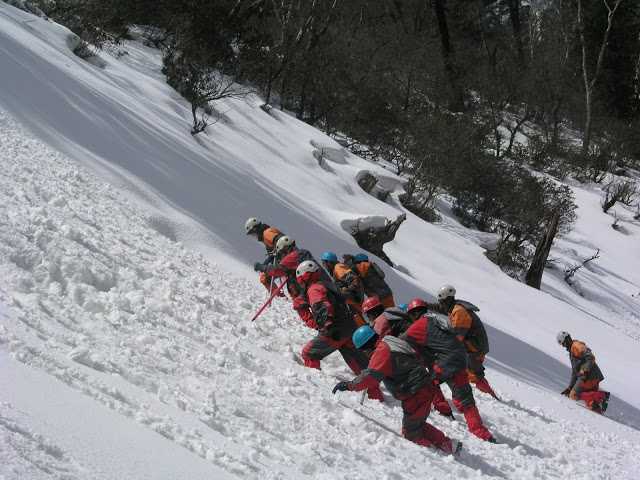
Advancing on a snowy mountain
Base Camp:
Dokriani Bamak was the place where we were to set our camps for ice craft during the mountaineering course. It was a 5 km trek. Though the distance was less (compared to the previous treks), the terrain was rough; the path was covered with rocks (result from melting of glacial moraines). We had to ferry the load (consisting of our tents which were being transported by porters up till now, our rations for the next 12 days, etc. up to the base camp and then come back (again) down to Gujjar Hut to carry back our own luggage.
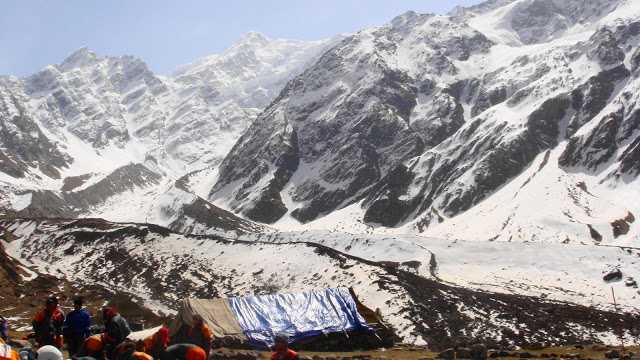
Dokriani Bamak glacier from our base camp
When we reached the base camp, I was really in awe (yet again) by the beauty of the place surrounding our camp. I was seeing a glacier for the first time. Moreover, it was sunny (a welcome change) on that day. Although there were virtually no trees there, the only vegetation was some kind of grass and a few flowers could be seen on rare occasions. The trees cease to exist after a height of about 13000 ft and we were at 13700 ft.
The toilet areas of the base camp were unbelievable – a precarious hill slope. We actually were supposed to do it on the hill slope. At first I thought it was only a joke, but was really taken aback when people started storming the slope to find a good pooping place. There were ropes put there so that we might catch hold of them in case one fell down.
Later that day a snow storm took us off guard. The complete area was covered with snow in less than 15 minutes. There was a white out, everything was white as far as one could see, with no distinction between the land and the sky and no prominent features visible. One had to brave the snow storm and carry a mess tin and have the food at the same time in this wild storm; still a few guys managed to sneak the food into their tents (which was forbidden).
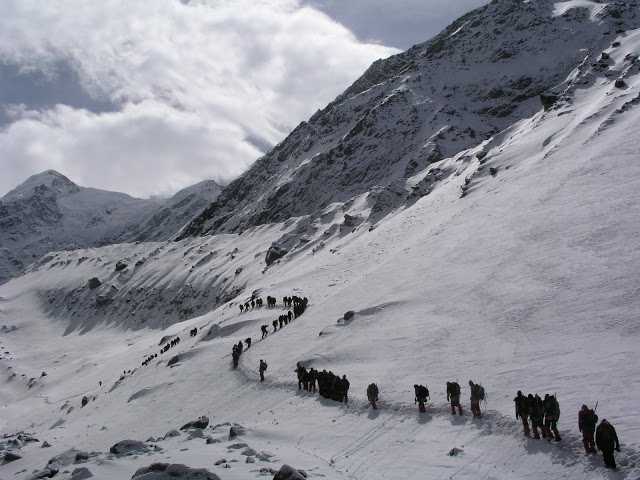
En route to our trekking area
We were to go to our training area located 4 km away from our camp on the glacier. Once we reached there, we had to remove the snow covering the solid ice with shovels. Thereafter we began our practice. We had to tie up crampons on our snow shoes, making the weight of the shoes still heavier, thus adding to our woes. While climbing on ice covered mountain, one needs to kick in the ice so as to anchor both the feet in and then strike hard with an ice axe. Once everything is in position, you move forward repeating the same procedure.
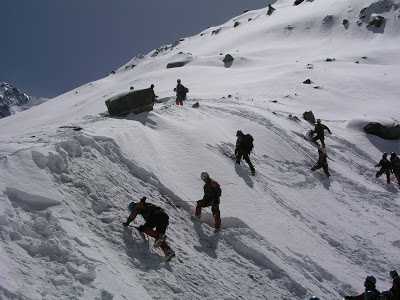
Ice climbing
Whenever we came back from our training, it always used to snow heavily. Many a times, we encountered a blizzard. Sun was a rarity: In the 14 days that we spent up, sun was out only for 2-3 days. Another problem that we faced was that almost every day, our gators, gloves, wind proof would get wet. Drying them was another uphill task. We used to keep them in our sleeping bags at nights and they would get dry by the mornings. In the same way, we kept our water bottles inside our bags to warm them up overnight. Mornings were particularly punitive. First, we had to go down find a place on the hill to take a crap. Thereafter, we had to come up to wash our hands in cold river water. After the whole procedure, the hands would remain numb for at least 20 minutes. I had to wear my contact lenses everyday, which was really difficult with numb hands. We were supposed to wear sun glasses; a person can go snow blind in one hour if he’s not wearing these glasses.
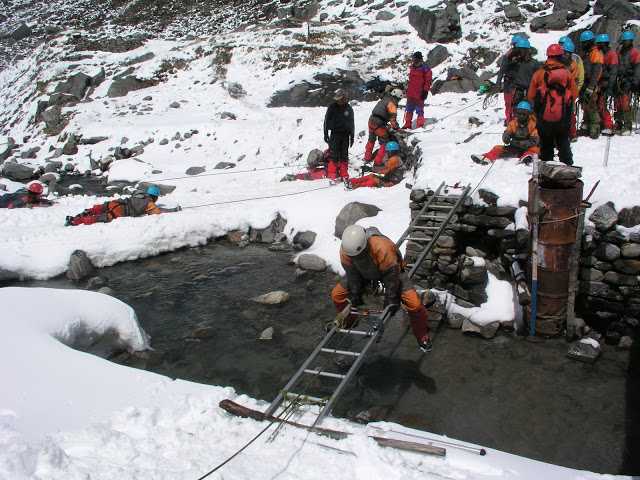
Crossing a crevasse (practicing here on a stream of water)
Finally came the day for height gain, in the mountaineering course, where we were supposed to climb up to the very névé (source or the top) of the glacier moving up from 13,600 ft to 15,600 ft. This journey was around 8 km long and was supposed to be the final test of strength. During our upward journey, I saw many able men fall down due to sickness. I had a chance to witness the hanging glaciers and blue ice (there are three types of ice – blue, black and white). After returning back, I washed my face (after 16 days). I felt so very happy that day. All the instructors (and even my rope mates) were amazed that I was able to climb up to that height without any help and without breaking down even once.
The next day, we had a navigation exercise, where we had to trace three co-ordinates in the surroundings taking into account the proximate land features. There were points for the team who would get to all the three places first. So we ran to our first location. It was 2 km from the base camp up towards the glacier. We reached the 4th which meant we still could overtake the other teams if we made haste. The second location was 3 km from the base camp antithetical to the glacier. While running down, my ankle got struck in a rock base and it twisted. Any kind of injury in such a cold weather magnifies the pain ten times. I was literally in tears when this happened. I was unable to move my right ankle. Half of my team mates caught hold of me and carried me back to the camp. I was given pain killer injection and some tablets. The doctor feared that this was a case of broken bone. I was in a state of horror. “How am I supposed to go back now?” It was the last day of our stay there. Thereafter we had a written examination (the toughest part of the mountaineering course for my army friends). The doctor ordered me that I would be taken back on stretcher the next day.
I was really relieved to get back to Tel. At Bhukki, our bus was waiting for us. On reaching Nehru Institute of Mountaineering, the first thing that I did was take a bath (making sure I wipe my ass thoroughly for I was using toilet paper for the past 18 days and was in the same set of undergarments). My face skin had darkened due to UV exposure (At such altitudes one requires a sunscreen of 50 SPF but I was carrying a 30 SPF one with me).
The Conclusion:
I was relatively pleased with myself for completing the mountaineering course. There was a time that I wanted to dropout and go back to my home. Many guys had actually left the mountaineering course midway. I’m now more aware of my physical (and mental) limitations. I learned some important aspects of lifetime management, discipline, dealing with strangers, etc. I am now certified to climb all peaks below the height of 6500m. My acrophobia is removed and I can honestly say that I’m not afraid of (many) things that I was previously afraid of.
I’m sure I would not be able to complete this mountaineering course had I not received the encouragement of the instructors and the enormous help that my roommates gave me. I truly recommend this mountaineering course for every individual.
The course schedule of Nehru Institute of Mountaineering can be found at http://www.nimindia.net/
Blog is originally written by Rohit Prakash for - http://reporter-raka.blogspot.in/2008/05/my-experiences-at-nim-nehru-institute.html
Have you visited our website to discover cool destinations in India for your travel plans?
